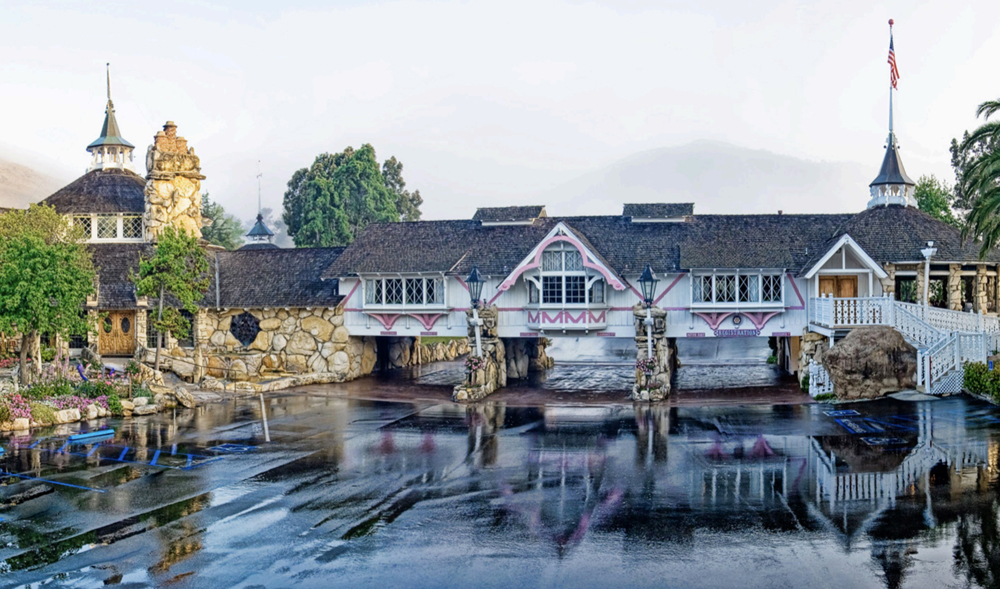Without knowing it, most people are significantly impacted by the architecture and interior design that surrounds them. On a long enough timeline, drab dwellings will create gloomy personas in their inhabitants. This is why an establishment like the Madonna Inn, practically a Central Coast institution, should be celebrated. It represents an increasingly bygone era of American travel and leisure that can be described as anything but gloomy.
Architecture is also a reflection of a unique place, and, more importantly, the people that inhabit it. It’s no coincidence that the English built castles of stone and mortar, the peoples of the ancient Near-East erected cities of mudbrick, and certain Native American tribes carved intricate abodes into the sides and tops of cliffs and mountains; these are direct representations of the peoples of particular locations and the materials they had available. Even in the wake of the industrial revolution—where masses of raw materials became available for worldwide megalithic construction—one would think structures would have immediately taken on an international aesthetic. Well, architecturally speaking, New York still looked different from Paris, which was even more different from Tokyo, and so on.
Departures from this truism were not widely prevalent until the ushering of “universal” ideas of governance and habitation, whatever that even means at any point in history. Modern architecture and design soon followed, erecting pillars of glass and steel; identical in Beijing, London, or wherever their foundations lay. It’s no surprise that within and around these obelisks of modernity, culture is equally universal and contemporary; it’s easier than ever to find a panini in Tokyo or tacos in Copenhagen. Most probably see this as a good thing, but something very remarkable is being erased.
Today, nothing is safe, not even a people’s own identity. A recent architectural fad of… tastefully updating… historic edifices has swept Western civilization. A few examples are Daniel Libeskind’s additions to Canada’s Royal Ontario Museum and the Museum of Military History in Dresden, Germany; as well as Zaha Hadid’s update on St. Antony’s College in the United Kingdom and the Port Authority building in Antwerp, Belgium. It’s a clash of old-meets-new, and the high priests of the architectural community are bowing down and praying to these newly constructed golden calves. However, I’m willing to bet that the average layman might mistake these tasteful additions as an alien invasion. Some of them appear as if the buildings are being subsumed by a galactic entity, foreign and menacing.
Architecture is also a reflection of a unique place, and, more importantly, the people that inhabit it. It’s no coincidence that the English built castles of stone and mortar, the peoples of the ancient Near-East erected cities of mudbrick, and certain Native American tribes carved intricate abodes into the sides and tops of cliffs and mountains; these are direct representations of the peoples of particular locations and the materials they had available. Even in the wake of the industrial revolution—where masses of raw materials became available for worldwide megalithic construction—one would think structures would have immediately taken on an international aesthetic. Well, architecturally speaking, New York still looked different from Paris, which was even more different from Tokyo, and so on.
Departures from this truism were not widely prevalent until the ushering of “universal” ideas of governance and habitation, whatever that even means at any point in history. Modern architecture and design soon followed, erecting pillars of glass and steel; identical in Beijing, London, or wherever their foundations lay. It’s no surprise that within and around these obelisks of modernity, culture is equally universal and contemporary; it’s easier than ever to find a panini in Tokyo or tacos in Copenhagen. Most probably see this as a good thing, but something very remarkable is being erased.
Today, nothing is safe, not even a people’s own identity. A recent architectural fad of… tastefully updating… historic edifices has swept Western civilization. A few examples are Daniel Libeskind’s additions to Canada’s Royal Ontario Museum and the Museum of Military History in Dresden, Germany; as well as Zaha Hadid’s update on St. Antony’s College in the United Kingdom and the Port Authority building in Antwerp, Belgium. It’s a clash of old-meets-new, and the high priests of the architectural community are bowing down and praying to these newly constructed golden calves. However, I’m willing to bet that the average layman might mistake these tasteful additions as an alien invasion. Some of them appear as if the buildings are being subsumed by a galactic entity, foreign and menacing.
While positive comments and likes for social media postings about this new architectural craze might imply universal praise, other arising cultural trends may suggest otherwise. In his book “Retro-culture: Taking America Back,” paleoconservative author William S. Lind dedicates an entire chapter to the resurgence of traditional family life. In addition, many millennials, currently buying their first homes, are clawing at mid-century modern furniture to fill their new digs; an interior design style—though “modern”—now seventy years old.
The mere fact that traditional family life is almost considered a type of counter-culture by the shapers of public opinion, is very telling of what we’re forced to like and hate. On the surface, mid-century furniture and the traditional families may not have a lot in common, but they both point back in time, the opposite direction from modern architecture literally engulfing traditionalism and paninis in Tokyo.
A local way to go back in time is at the Madonna Inn. Now, it might seem difficult to suggest a hotel offering themed rooms labeled “China Flower” and “Swiss Rock” is indicative of the Central Coast of Califor- nia, but maybe it’s more so than first meets the eye. The Madonna Inn emanates Americana, a nostalgic and upbeat portrayal of the American experience and culture. What was once considered new and unique, then became kitschy and maybe even a little cheap, now comes off as something distinctive and fun; simply because of its lack of updates and modernizing.
The mere fact that traditional family life is almost considered a type of counter-culture by the shapers of public opinion, is very telling of what we’re forced to like and hate. On the surface, mid-century furniture and the traditional families may not have a lot in common, but they both point back in time, the opposite direction from modern architecture literally engulfing traditionalism and paninis in Tokyo.
A local way to go back in time is at the Madonna Inn. Now, it might seem difficult to suggest a hotel offering themed rooms labeled “China Flower” and “Swiss Rock” is indicative of the Central Coast of Califor- nia, but maybe it’s more so than first meets the eye. The Madonna Inn emanates Americana, a nostalgic and upbeat portrayal of the American experience and culture. What was once considered new and unique, then became kitschy and maybe even a little cheap, now comes off as something distinctive and fun; simply because of its lack of updates and modernizing.
Many of its rooms illustrate this; the “Country Gentleman” room feels like a trip to your grandparents’ house (this is a good thing), the “Yahoo” room exudes the history of the American Western experience, and the “Love Nest” and “Madonna Suite” are perfect for young couples looking for fun, only slightly tongue-in-cheek romance… they’re also all very Instagramable. The Inn’s restaurant serves classic American fare, and its multiple spires perfectly match the green hills behind the hotel, like a Bavarian castle with an Alpine backdrop. This, too, makes sense, given the Swiss origins of the hotel’s founders and the historic German and Dutch population of settlers in the region; do I even need to reference nearby Solvang? I’ll admit that all the pink can be a little jarring, but I see this as representative of something specific to that 1950s and ’60s optimism that so many people seem to be attempting to regain. Contrasting the Inn’s vibrant colors with the mundane slabs of concrete and blinding glass of more current tastes, it’s more welcoming than anything.
The architectural oligarchs of modernity couldn’t be bothered with a locale like the Madonna Inn. Firstly, it’s not state-owned, and even if it was, it’s not nationally valuable enough to be targeted for defacement, and this is a good thing. Locals and tourists alike can continue to enjoy one of the Central Coast’s most niche landmarks, unencumbered by the ever-changing tide of modernism.
The architectural oligarchs of modernity couldn’t be bothered with a locale like the Madonna Inn. Firstly, it’s not state-owned, and even if it was, it’s not nationally valuable enough to be targeted for defacement, and this is a good thing. Locals and tourists alike can continue to enjoy one of the Central Coast’s most niche landmarks, unencumbered by the ever-changing tide of modernism.





